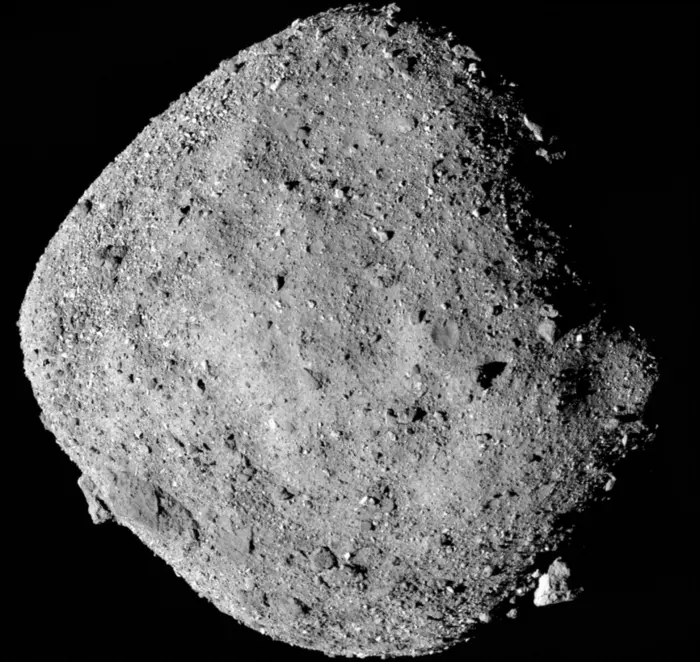
NASA’s OSIRIS-REx mission has made groundbreaking discoveries from the samples returned from asteroid (101955) Bennu, revealing critical insights into the potential origins of life on Earth. In a significant collaboration with Japanese scientists, a comprehensive analysis has shown the presence of all five nucleobases—adenine, guanine, cytosine, thymine, and uracil—in samples collected from this ancient celestial body. This discovery is revolutionary as it supports the hypothesis that asteroids may have played a key role in delivering the necessary building blocks for the formation of life.
Asteroids, the remnants of the early solar system, have long fascinated scientists due to their primitive nature and composition. They are believed to hold secrets about the conditions that existed in the early solar system and, by extension, the origins of life itself. The OSIRIS-REx mission, which managed to collect pristine samples of Bennu’s surface materials, provided a unique opportunity to study these building blocks without the complications introduced by exposure to Earth’s atmosphere or biosphere.
The 121.6 grams of samples returned by OSIRIS-REx in September 2023 represent the largest collection ever retrieved from an asteroid. This groundbreaking mission has opened a new era of astrobiological research, enabling scientists to conduct high-resolution analyses in controlled environments. Under extremely sterile conditions, these samples were handled and processed to extract vital information about their chemical composition.
A collaborative team, utilizing advanced high-resolution mass spectrometry, carried out extensive research on the samples obtained. The results indicated that the concentration of N-heterocycles—organic compounds that include nitrogen—was significantly higher in Bennu’s samples than in those retrieved from asteroid Ryugu. This discovery suggests a rich chemical diversity that could provide insights into the processes that led to the creation of organic compounds in our solar system.
In addition to the primary nucleobases, the researchers also identified other nitrogen-rich compounds such as xanthine, hypoxanthine, and nicotinic acid. These findings suggest a myriad of possible biochemical pathways that may have been available to primitive life forms, pointing to an intricate network of organic chemistry present on Bennu. This discovery is particularly exciting as it underscores the potential connection between extraterrestrial environments and the development of life on our planet.
The Japanese team’s analysis revealed not just the presence of nucleobases but also a possible explanation for the different ratios observed when compared to other celestial samples. The differences in chemical abundance and complexity between Bennu and Ryugu are hypothesized to stem from variations in the environments each asteroid has experienced. It raises questions about the external influences that shaped their respective chemical landscapes during their time in the solar system.
Moreover, the study has revealed intriguing contrasts in the ratio of purines to pyrimidines in Bennu samples compared to carbonaceous meteorites such as Murchison and Orgueil. This information adds another layer of depth to our understanding of asteroid composition, hinting that each asteroid bears the fingerprints of its unique history and the specific locations from which they originated.
The significance of these findings extends beyond just the chemical identification of organic compounds. By establishing a baseline understanding of the chemistry found on Bennu, researchers can now reanalyze meteorite samples collected on Earth, thereby enriching our knowledge of extraterrestrial chemistry. This aspect could lead to a more profound understanding of how life might arise in diverse conditions beyond our planet.
The meticulous handling protocols for the samples were paramount in ensuring their integrity and preventing contamination from terrestrial substances. Each sample was analyzed under nitrogen conditions, showcasing the commitment of the OSIRIS-REx team to maintain the purity of their findings. The research underscores the importance of such missions in refining our understanding of astrobiology and planetary sciences.
As the scientific community delves deeper into the complexities unveiled by these sample analyses, a collaborative effort among researchers, institutions, and nations will be crucial. The work of scientists from Japan, in conjunction with their American counterparts, exemplifies global cooperation in addressing fundamental questions about the origins of life. The interdisciplinary nature of this research symbolizes a collective journey towards uncovering the mysteries of the cosmos.
In conclusion, NASA’s OSIRIS-REx mission and the subsequent analysis of asteroid Bennu’s samples represent a pivotal moment in our quest to understand the origins and building blocks of life. The discoveries made by the international team highlight not only the significance of asteroids in containing primordial materials but also their role in unraveling the genetic codes that may have once sparked life’s beginnings on Earth. As we continue to explore deep-space environments and their contributions to our planet’s early history, the excitement around astrobiology only grows.
These advancements herald a future where our understanding of life in the universe becomes richer and potentially more connected to the broader narrative of planetary evolution. The intersection of chemistry, astronomy, and biology provides a fertile ground for further exploration, urging researchers to remain attentive to the tales told by the materials retrieved from distant worlds.
Subject of Research: Chemical composition of extraterrestrial samples from asteroid Bennu
Article Title: Abundant ammonia and nitrogen-rich soluble organic matter in samples from asteroid (101955) Bennu
News Publication Date: 29-Jan-2025
Web References: Nature Astronomy Article
References: Not available
Image Credits: NASA/Goddard/University of Arizona
Keywords
Asteroids, Organic Chemistry, Astrobiology, Space Exploration, Nucleobases, Celestial Bodies, Chemical Analysis, Sample Collection, Planetary Science, Extraterrestrial Life, Space Missions, OSIRIS-REx
Tags: asteroid composition analysisastrobiology advancementsBennu asteroid samplesbuilding blocks of lifecelestial body studiescollaboration with Japanese scientistsearly solar system explorationextraterrestrial life potentialNASA OSIRIS-REx missionnucleobases discoveryorigins of life researchpristine sample collection techniques





